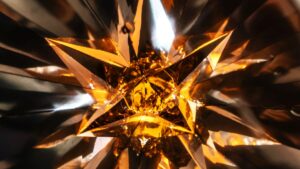
A groundbreaking discovery in physics has emerged with the development of a time crystal that exhibits a unique blend of order and chaos. Researchers have successfully demonstrated the existence of a time rondeau crystal, which oscillates in a manner that is both repetitive and unpredictable. This finding opens new avenues for understanding how matter can experience time, showcasing a novel form of temporal order that arises from complex interactions.
The research team, led by Leo Joon Il Moon from the University of California, Berkeley, alongside Paul Schindler from the Max Planck Institute for the Physics of Complex Systems in Germany, highlighted the significance of their findings in a paper published in Nature Physics. “In this work, we reveal the existence of new types of temporal order, arising from non-periodic but structured drives,” they explained.
Time crystals were first theorized by US physicist Frank Wilczek in 2012 and were observed for the first time in 2016. They represent a new phase of matter, distinguished from traditional crystalline materials, such as diamond and quartz, which feature repeating atomic structures. In contrast, time crystals allow particles to oscillate in ways that are not governed by external forces, creating a dynamic interplay of order and chaos.
The research team defined a time rondeau crystal as a unique entity that alternates between structured order and disorder, akin to the musical form known as a rondeau. “A pattern comprising a repeating theme that alternates with a contrasting variation theme is known in classical music as a rondeau,” the researchers noted, referencing the famous Mozart’s Rondo alla Turca as an example of this concept.
To create their time crystal, the researchers utilized atomic-scale voids, known as nitrogen-vacancy centers, within a diamond. These centers exist where an atom is missing, creating an empty lattice site. By using lasers to excite these nitrogen-vacancy centers, the team was able to hyperpolarize the nuclear spins of carbon-13 atoms in the diamond. They then employed a programmable arbitrary waveform generator to drive the spins through a series of precisely timed pulses, which varied from periodic to random sequences.
Over the course of their experiments, the researchers monitored hundreds of drive cycles. They discovered that the time crystal could oscillate for over 4 seconds before losing coherence. Despite the presence of disorder within individual drive cycles, the overall state of the time crystal exhibited a repeating pattern at the start of each cycle, similar to how a strobing light can capture repeated sequences in motion.
Taking their experimentation further, the team encoded a message into the timing of the pulses, reading: “Experimental observation of a time rondeau crystal. Temporal Disorder in Spatiotemporal Order.” While this may not have immediate practical applications, it showcases potential future uses for the concepts derived from their research.
“Our experiments open a promising new avenue to investigate temporal order,” the researchers concluded, emphasizing the stable coexistence of long-range temporal order and micromotion disorder at short timescales. This innovative study not only expands the understanding of time crystals but also lays the groundwork for future explorations into the complexities of time and matter.







